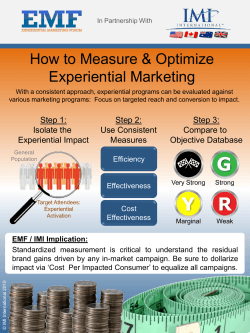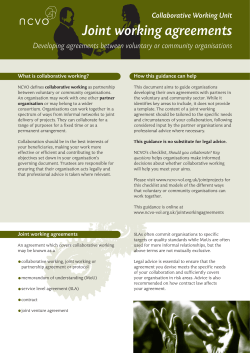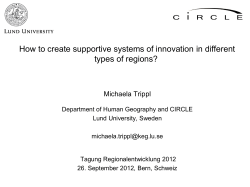
How to Keep Clients Forever
How to Keep Clients Forever Introduction Keeping and growing clients forever - A.K.A. client relationship management, or key account management - is an essential but much misunderstood part of growing a firm. It should in theory be easier than winning new business from scratch, but many people approach it with erroneous ideas; assuming, for example, that work will flow in just by doing a great job or providing a terrific service. I learned the hard way - took over the running of a firm where at one point for every £5 million in new business we won, we lost £750K from existing clients leaving or projects completing. Not quite Sisyphean, but pretty close. Keeping and growing clients forever is hard but not difficult. It takes some simple planning tools, and a whole lot of effort to put them to use, plus a number of internal disciplines have to be in place. And in many firms it is the internal disciplines that are the hardest to get right. And from their point of view, they already trust you and have built up some degree of rapport so why would they not want to give you more business. That’s the first thing to check, of course. Unless they really are delighted with your work and the health of the relationship (and they are happy with you personally, as well as the rest of the team), they will not give you any more work. And so you need to be confident this is right, right from the start. Sometimes you “just know” the strength of the relationship, but often it is better to undertake research amongst clients (this is old hat in many professions, but an alien and frightening concept in some). Some partners are highly resistant to proper, independent research which in my experience is something of a warning sign for the real strength of their client relationships. 4 myths about service The role of service in keeping and growing clients is crucial but often misconstrued. In particular, there are four myths that need to be quashed: 1. This short paper looks at: • Why client relationship management should be easy; • 4 myths about service; • A six part process for doing it properly; • What gets in the way of success. Why it should be easy Anyone trying to build their business should start with their existing clients rather than chase new-new business. You know the clients well, so you should understand what their objectives and issues are; you know how they like to work; you know the personalities there, so you are able to negotiate the office landscape better than an outsider. 2. Firstly, doing a good job is not the same thing as providing a good service. You may have undertaken, say, a due diligence investigation perfectly competently, on time and within budget. But that is the minimum the client expects from you – doing a good job is a “hygiene” function and is not the same thing as excellent service (and if you work for HMG on major contracts, you should know that part of your fee will be tied to providing super-service i.e. if you “just” do exactly what has been agreed, you will not get all of your fee, as you have to be seen to be delivering over and above…). The second trap is that many firms offer free add-on’s: knowledge transfer, seminars, staff training, etc as a demonstration of tangible value for money, and they assume this is also regarded by the client as an element of good service. But if these freebies are Sutherlands Growth Guaranteed 3. 4. offered by your competitors; if they are confused with the things the client is really looking for in service terms (joined up thinking across practices; joined up thinking across geographies; continuity of personnel; accessibility; communication; etc) then their contribution to the service element of your offer will be marginal. Thirdly, it is often assumed that doing a good job and giving great service will protect your client base. Unfortunately you need to do more than that, because if your client network is too narrow and your contact moves on, their replacement may well be inclined to use their favourite firm and you could be out in the cold (the silver lining, that you may be hired by your contact wherever they end up, is scant consolation for losing the original client). And finally, doing a good job and providing good, even great service, does not of itself automatically lead to more work; there’s more that you have to do to keep the income flowing in. The six part process Keeping and growing clients is a six part process: 1. You firstly have to work out which clients you should spend time with, and then: 2. Work out who to go after within each client; 3. Get close to them; 4. Find out (ideally anticipate) their needs; 5. Delivery; 6. Repeat. Work out which clients to go after Select clients using “Maximise Gain” or “Minimise Loss” criteria. For example: Maximise Gain • Clients that are growing fast • “Flagship” clients (“prestigious” clients where you make little actual money) • Big clients where your share of wallet is small • Big clients in economic difficulty • Clients where there is a very strong relationship Minimise loss • Important clients (irrespective of size) where you face a real competitive threat • Big clients where the relationship is too narrow (whether by contact, geography or service line) • Big clients where the share of work is static or shrinking • Big clients likely to consolidate their professional service providers Work out who to go after within each client This is called client mapping and requires you to identify the individuals within the client (and other stakeholders who have influence over the allocation of further work, such as nonexecutives, other advisers, etc), then assign each a “role” which identifies their influence over the allocation of work to your firm (the “decisionmaker” is the best known role, but there are others such as those with power of veto, etc), and noting the extent to which (a) they know your firm and (b) how highly they rate it. This can be done in your head, or on the back of an envelope, or using specialist software. The chart on the next page illustrates the process. If you have an extensive client base, then portfolio theory provides a way of determining how much resources to apply to which clients. If you have a more manageable client base, then a set of pragmatic principles will do perfectly well instead. Sutherlands Growth Guaranteed The next two parts of the process form the core of providing great service. And as professional services are, from the client’s point of view, largely an experiential business, service is incredibly important. A simple chart might look like this: CLIENT X Service can be expressed by the formula: NAME TITLE ROLE KNOW US RATE US J Anon Trustee Veto N ? J Smith CEO Decision -maker Y Y This is perhaps best known by the mantra: “under promise and over deliver”. J Doe CFO Veto N ? Get - and stay - close to them AN Other 1 Division head Coach Y Y AN Other 2 Team leader Contact Y N AN Other 3 Ops lead Contact Y N A more complex chart might highlight links and relationships between the individuals and in smaller clients this could be something you already know, intuitively. With larger clients you need to ask questions of people (“...so who else might have a stake in this decision…”) in order to reveal the individuals, their roles and, if relevant, the relationships between them. The chart gives suggestions as to where you should be spending your time working your way into the client. Of the 6 individuals here, there appear to be two gaps in our internal network and two individuals who may not - for whatever reason - rate us highly. Since the former have the potential to disrupt our being given further work, it makes sense to prioritise them; since the latter do not - as far as we can work out - have the power to influence our appointment, we can defer reaching out to them until after we have the more important players sorted out. The key thing is to get on and do it. And if you have a substantial client where your contact base is relatively narrow, then you should think about getting on with it sooner rather than later. Service = Experience minus Expectation This is essential. You have to get to really close to understand your client, in order to detect what their expectations are of your firm and of the work you are doing for them (so you understand how you can exceed their expectations - or manage them downwards...). You need to understand their personal goals, likes and dislikes, so you can become a pleasure to work with. And if you have a strong relationship with them, they can help you in the mapping process. This is all perfectly straightforward and can be summed up by the old adage “be interested in your client”. It is a matter of establishing a high degree of trust and rapport and anyone who is really proficient at networking should find this pretty easy, albeit time consuming. Find out (ideally anticipate) their needs Again, for individuals who are good at networking or have an innate understanding of what clients are seeking, this should be straightforward. Client needs include what some refer to as the soft stuff (in the auto and hotel industries, these are referred to as ‘moments of delight’) - small things - remembering birthdays; sending over press cuttings; making a phone call when others would send a formulaic email; responding fast to requests; etc - which demonstrate that you are really interested in the client (and are well organised, too). Sutherlands Growth Guaranteed In an experiential business, this stuff really counts, so pay attention to it! But do not do the soft stuff at the expense of what the client regards as being the core of great service, which is usually a combination of out-performing on existing work and helping them achieve their business objectives, by coming up with a stream of suggestions for them to consider. Some of the obvious things you can do to generate the latter are: • Pointing out issues faced by other clients which operate in the same sector or geography (theoretically, colleagues elsewhere in your firm should be able to help you with this); • 1:1 market research and follow-up group discussions may reveal requirements you were unaware of; • Brainstorming sessions with the client and a team of your colleagues can produce possible answers to what the client may have thought of as intractable problems; • Brainstorming sessions about the client, with colleagues elsewhere in your firm; • Presentations by the client to your staff about the client’s business and sector can deepen your understanding of the client's business and spark ideas as a result; • Senior partner “health check” discussions with the client can reveal shortcomings that politeness had previously obscured; • “Walking with the corridors” and asking around can alert you to issues and challenges you may be able to help with; • Participating in client events can give you “insider” status that may make you privy to challenges you were not previously aware of. There’s a lot that can be done to get close, stay close and generate ideas they may find valuable. Delivery This starts with working out what, amongst the myriad of things you could deliver, you should actually put to the client (how and when to ask for the business is covered in a separate paper). You can use tools such as Force Field Analysis, which ranks opportunities and obstacles, to help you determine the highest priority opportunities and what you need to do to get past the inevitable roadblocks along the way. And then you have to actually deliver. The key point to grasp here is that as far as your client is concerned, you are the guarantor of delivery, even if it is another part of your organisation actually doing the work. If “guarantor” is not a role you are comfortable with, and you simply want to be the sort of professional who just does the technical stuff and that’s the end of it, then you need to give way to an account manager and let them run what you may have thought of as “your” client. To the uninitiated this may be painful, but account management is an essential role and if you do not do it... Repeat Client relationship management is for life, not just something you do every now and again when you remember to. Keep going through the cycle and you will find that your client’s perceptions of service climb and your revenues grow. Margins should increase as well, as you become more slick at providing just the services the client values most. And if you go through this cycle time and again, you will find that you build in protection against client contact departures, against the arrival of new personalities, against the ups and downs of fortune that all clients face along the way. My old firm’s record for retaining and growing a clients is 23 years and counting - with 5 changes of CEO along the way. There’s no reason why your firm cannot emulate or beat this. Except for what often gets in the way... What gets in the way Misunderstandings about the process aside, there are a number of significant challenges to be overcome if your firm is to undertake really effective client relationship management: Sutherlands Growth Guaranteed • Sometimes, delivery – if undertaken by colleagues elsewhere in the organisation – is a major issue. The straight truth is that many partners feel it is rational behaviour not to ask colleagues to undertake work for their client, since they feel they have nothing to gain and everything to lose by referrals. This is because in some organisations, partners simply do not trust each other sufficiently and in others – particularly the larger ones – they do not know each other. • Some firms effectively operate a form of “eat what you kill” process, despite whatever they may claim in public. I have always found the attractiveness of this system overrated. It is presented as pure Darwinism, overlooking the fact that nature’s top predators tend to hunt in packs. • In some organisations, billings targets work against spending time on marketing, or client relationship management initiatives or helping others cross sell additional services that clients would find valuable. • The firm’s systems may not readily enable an overview of work being done by various teams, or easily provide an overview of consolidated billings and profitability, making it hard to work out whether too much or not enough work is being done for any given client. • Client service reviews may become Star Chambers that discourage participation in service initiatives. • The organisation’s remuneration systems may not cope well with those who generate income as opposed to those who execute the work (or they may have what is in effect an internal market, where deals are negotiated on a case by case basis by the individuals involved. Very collegiate, that). • Some organisations do not operate an account management system and find that one set of partners resent being giving “orders” by other partners, as they misunderstand the role they are trying to play. • And in many firms there is a poor understanding of basic professional services marketing, sales and relationship skills. • In some organisations there is complacency or inertia which have to be overcome. • And in many firms, the essential truth that professional services is in large part an experiential product is missed, with the result that the culture which can deliver great service is absent. These are all serious issues which have to be dealt with (and are the subject of a different paper). But there is nothing inherently complicated or difficult in client relationship management, and as professional firms increasingly come to resemble one another, this area holds the promise of real, powerful differentiation. Sutherlands Growth Guaranteed We work with ambitious organisations to help them grow, faster. We are exceptionally good at making your organisation and your people more successful in planning, attracting, winning, keeping and growing clients. Chris Matthews cmatthews@sutherlandspsbd.co.uk 0203 286 9216 www.sutherlandspsbd.co.uk Sutherlands Growth Guaranteed
© Copyright 2025





















